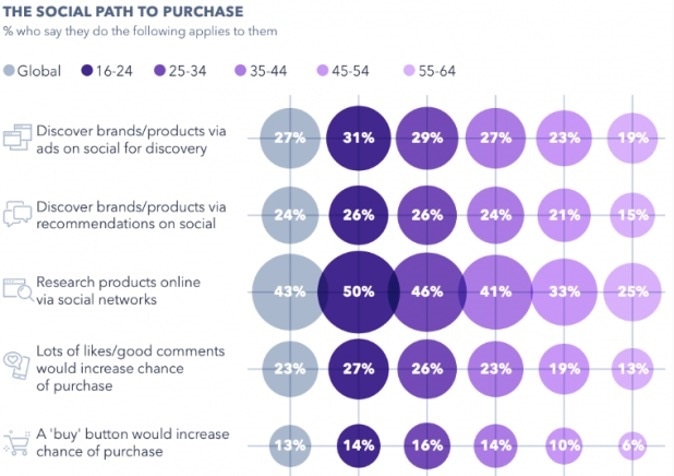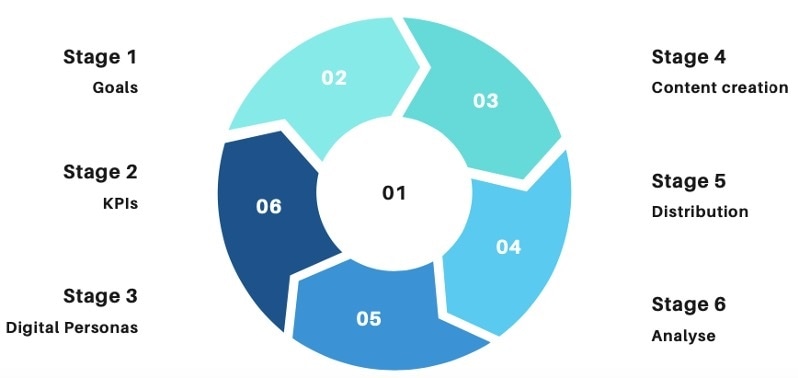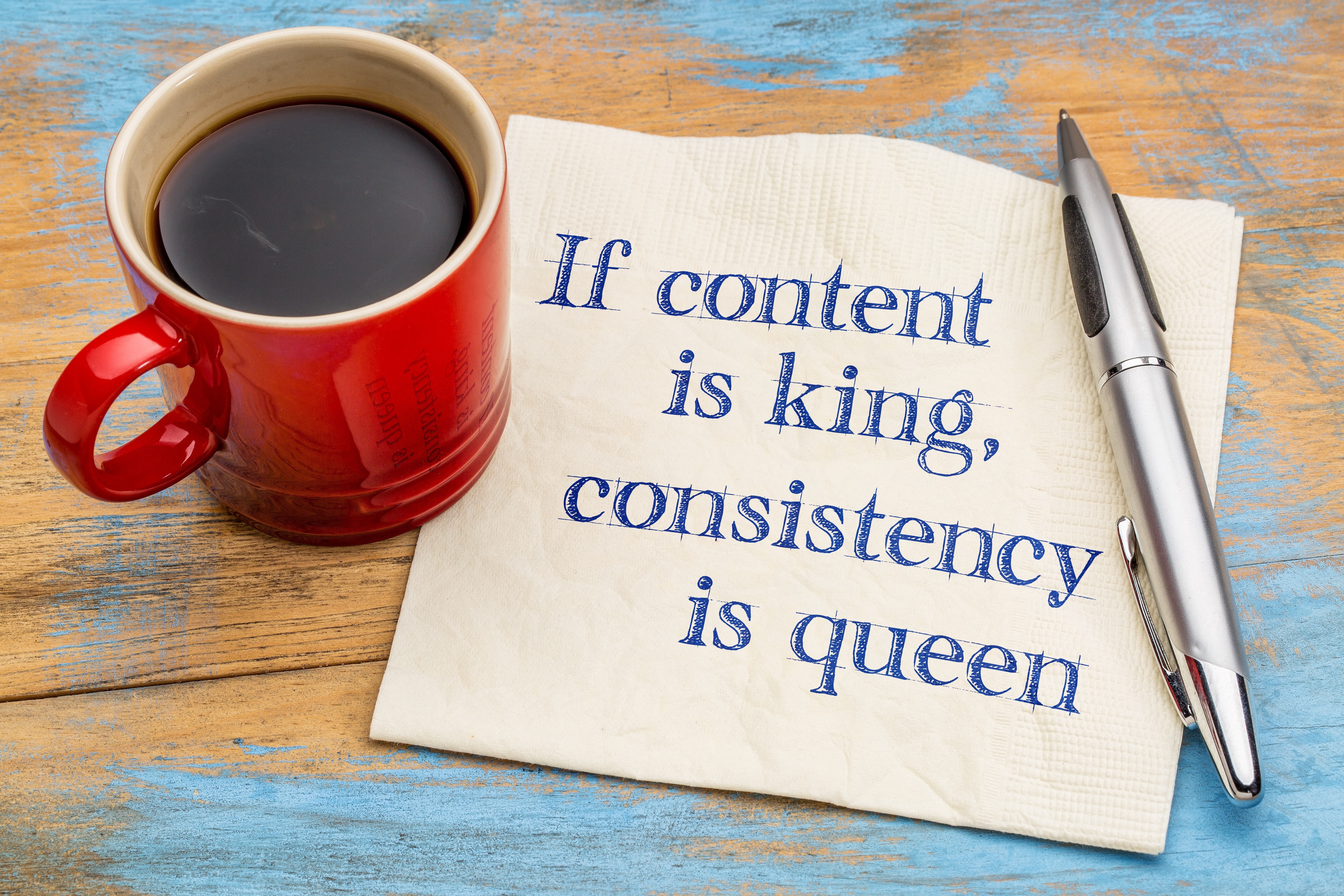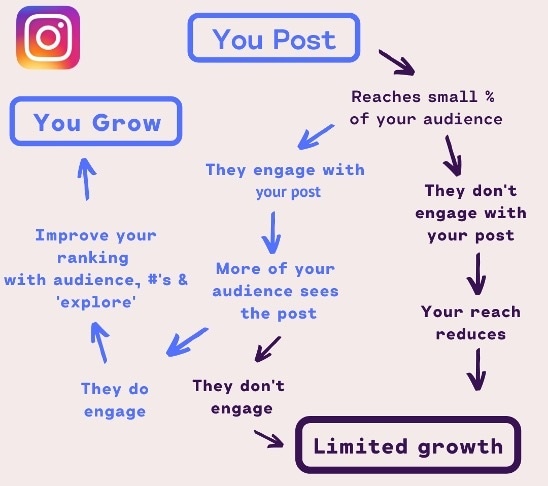
Life science social media marketing can provide your business with several benefits. With over 3.5 billion worldwide users, social media continues to grow in terms of users, daily engagements, and as a method to research businesses.
As a life science digital marketer, you can use social media to establish yourselves as the go-to organization for your area of expertise. The content you produce gives your business a human feel, making it more relatable to the target market. Additionally, by posting consistent, high-quality social media content, you will keep your business top of mind with prospective and current customers.
A successful social media marketing strategy can increase awareness, boost engagement, and generate leads. The diagram below highlights the importance of high-quality social media content across the whole customer journey.
The high percentage of consumers who use social media to research a company and its services is valuable when assessing whether your life science company should employ social media marketing in your digital strategy.

Figure 1 - The social path to purchase
This blog post is broken into three areas of focus that will support your life science social media marketing strategy. This blog piece will hopefully help you further develop your business's social media presence to grow your customer base and build trust with your target audience.
Although, it is essential to remember that this blog will focus on aligning social media marketing with a customer’s pain points and reaching overall business objectives. Therefore, content creation serves the customers and helps achieve business growth.
1. Create
The creative side of the process is often the most challenging, especially when taking a complex subject and breaking it down into social media-ready content. A shared white paper will not gain the audience's attention, unfortunately. This post has broken down the creative side of the process into four main areas:
Goals – Creating your goals with social media is a fundamental step. Common goals include increasing brand awareness, generating high-quality leads, or boosting engagement. Decide your goals by ensuring that they align with your overall business objectives.
KPIs – Creating KPIs to measure the success of your social media content. These could include:
- Brand awareness: number of followers/website traffic
- Lead generation: sales revenue/lead conversion rate
- Boosting engagement: number of followers/social shares/social mentions
Remember that your social media goals will likely overlap with the broader business objectives: Increased brand awareness on social media will increase sales, for example.
Personas – It is important to understand your audience and their pain points by creating personas based on in-depth research. Adding a digital aspect will strengthen your relationship with your audience and enhance your social media strategy. Personas are also key to your wider digital marketing strategy for life sciences, as they assist in understanding your target audience.
Cater to your persona:
What digital devices do they use? Do they prefer video or written content? What is their preferred social channel? How do they research a product before they buy it?
Research the channels they use and analyze the type of content that they engage with, and then align this with your life science content marketing strategy.
Content – Create valuable and interesting content that educates and engages your audience. With a laser-eye focus on your goals, KPIs, and personas, you can create content that answers your customers' pain points by meeting their digital requirements and generating interest in your services.
Video has become a valuable tool for relaying a brand's narrative. It is an excellent way of breaking down a complex product or concept into a more digitally-digestible piece of content.
The image below summarises the points highlighted above and the first stages of your social media marketing.

Figure 2 - Social media marketing cycle
2. Distribute
Now that you have great content to work with, you can concentrate on getting it in front of the right audience.
PlanningUsing a social media content calendar will help you plan and organize your life science marketing strategy for social. Planning also gives you more time to focus on other aspects of your marketing.
Choose your social channels – The research into your digital personas will help you choose which social media channels to focus on: Twitter, LinkedIn, and Facebook can be great for B2B and Instagram is growing ever more popular with a younger audience of life science marketers so presents an opportunity for your organization.
Frequency – If content is King, then consistency is Queen.

The focus should always be on the quality of your content instead of the quantity and time you post. Although, each social media channel has a unique content algorithm. Below are a few tips for the leading platforms from a 2020 HubSpot report.
LinkedIn: This is mainly a B2B platform. It suggests posting during traditional working hours and avoiding scheduling posts for the weekend. Ideally, don’t exceed one post a day.
Facebook: The Facebook algorithm will punish your business page if you post too frequently and achieve low engagement, so it is recommended between 2 – 5 posts per week.
Twitter: Tweet as freely and as frequently as you like but remember to focus on the content that helps you meet your goals.
Instagram: Use relevant hashtags, ensure you use high-quality photos, and write detailed, interesting captions. Below is a clear explanation of how Instagram can help you bring your business to life with engaging content.

Figure 3 - How to grow on Instagram
Top-tip: Spend time before you post by engaging with hashtags relevant to the content. Then spend time after posting to engage with people commenting on your post.
Shareability – Make sure your content is shareable; this ensures that those who engage with your content can share across various social media and marketing channels. Having a clear option to share will dramatically increase your reach.
Use your teams – This is often ignored by many businesses but is a powerful tool as your team is your greatest advocate. Encouraging promotion and sharing company content is a positive way of increasing your reach.
Invest in ads – Investing in social advertising can be a very effective way of getting your best content in front of the right audience. The diagram below highlights how this can help generate interest in your services while providing leads to upsell other services.
>>>Read More: A guide to running social media ads<<<

Figure 4 – Value pyramid
Great content is wasted if your desired audience never sees it. Using these distribution tips will ensure that doesn’t happen. Analyze your results to help you constantly learn about your audience so you can adapt and improve your digital marketing for life sciences.
Distributing through other channels is also important. See how you can connect your content with our life sciences audience by clicking the link below.
3. Analyze
Begin your analysis by considering the following questions:
- Have you met your KPIs?
- Why have you succeeded or not been successful?
- What can you do to improve?
Revise and repeat!
Focusing on the areas above will enable you to learn what has the most positive impact on your audience and allow you to adapt your life science marketing strategy to ensure best practice.
A well-thought-out social media strategy is a fantastic way for life science marketers to increase awareness, boost engagement and generate leads. Following the steps in this blog post will help you to develop your social media marketing and boost your overall marketing efforts. Social media requires a consistent effort. Implement the above suggestions to increase your success on social media.
You can also get in touch to see how AZoNetwork can help boost your social media marketing, email marketing, and more.